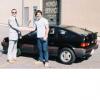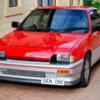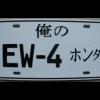And I stumble across a very interesting bit of info. So will the real performance guys on this forum please explain something to me.... (this especially means kakabox, jsgprod, Greg Gauper, and the rest of you true race/engineer guys!)
Wilwood is a well known and respected aftermarket brake systems maker. I'm sure they have some of the smartest people on their staff. After all, they do business in a market that has a VERY high liability. BRAKES! So they don't want to get it wrong if you know what I mean....
Wilwood sells a really nice big brake kit for the 2G/4G civic part number: 140-8695 http://www.wilwood.com/PDF/ds491.pdf
A really nice kit! Well thought out and with nice large 11" rotors. Just small enough to fit under a 15" wheel! I'm think'n, I'll copy the kit so it fits the 1G, right? Then I discover this:
The effective caliper piston area is actually smaller than the stock 1G CRX caliper!
What? I was under the impression the larger caliper piston diameter, the better braking. The effective caliper piston area for the stock 1G is 2,042.821 square milimeters. The caliper Wilwood uses in their big brake kit is only 1,929.947 square milimeters.
So here are my questions (finally!):
Is the most effect on braking power due to the longer effective arm of the larger diameter rotor? Or, if I'm going to run with a larger diameter rotor, do I really need to use a caliper with a larger effective piston area?
I know people get great results from a Teg caliper and rotor swap. But the Teg rotor is only 9.53" in diameter (I want a bigger rotor, I know, it's a penis thing
My goal is to stop better. I also like the look of the larger rotors. I'm also thinking about buying the Wilwood calipers for their cool looks!
That is all!
David
 Sign In
Sign In Create Account
Create Account





 Back to top
Back to top

 View Garage
View Garage

















